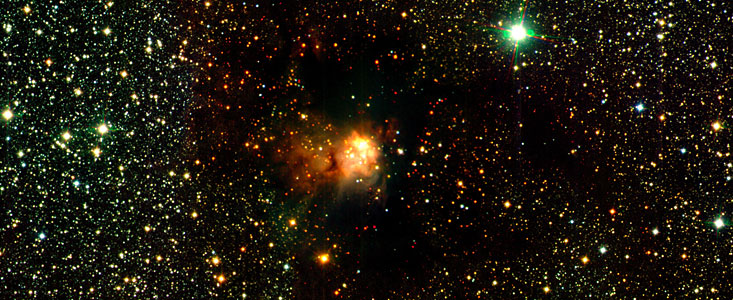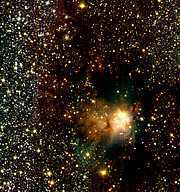Komunikat prasowy
Stellar Birth in a Dark Cloud
A Unique, Wide-Field Infrared SOFI Image of RCW 108
27 października 2000
A remarkable, wide-field infrared image allows to see in unprecedented detail the inner regions of RCW 108, a large complex of stars and nebulae in the southern Milky Way. It is one of the widest, "deepest" and most spectacular infrared astronomical images ever obtained of a starforming region. It is based on approx. 600 individual exposures with the SOFI multi-mode instrument on the ESO 3.58-metre New Technology Telescope (NTT) at the ESO La Silla Observatory (Chile).
A mosaic of 600 exposures
The above infrared view (ESO Press Photo eso0037a) of an interesting region in the Southern Milky Way, full of stars and nebulae and known as the RCW 108 complex, was obtained in February 2000. It provides a deep look into a star-forming region, where stars are in the process of being born from dense clouds of dust and gas.
It is particularly interesting to compare the appearance of the area in this infrared view (SOFI) with that obtained earlier at visible wavelengths (WFI). As they look quite different, such a comparison is greatly facilitated by referring to the positions of the same brighter objects in the two photos.
In visible light, the Eastern edge of the cloud appears as a bright rim; the same edge is present, although less prominent to the left in the infrared image. This is where the outer surface of the cloud is eroded and later completely dissolved by the strong ultraviolet light of a nearby cluster of stars, that lies beyond the edge of the infrared image.
Dust obscuration
The bright nebula IRAS 16362-4845 at the center of the infrared picture is much more prominent here (see ESO Press Photo eso0037b) than in the visible one. This is because it is deeply embedded in the cloud and its visible light is heavily obscured by the dust particles. This effect is much smaller at longer (infrared) wavelengths, so the SOFI image provides a more detailed view of IRAS 16362-4845 .
It is exactly this greater transparency of interstellar dust clouds in the infrared spectral region that is one of the main reasons why studies of very young stars are best carried out at infrared wavelengths. Such stars are often still surrounded by the remnants of their parental gas and dust clouds.
The colours of the stars
Dust not only dims the light of objects located behind the cloud, but also "reddens" it. This is because shorter-wavelength (e.g., blue) light is scattered out of the line-of-sight more efficiently than is longer-wavelength (e.g., red) light.
This effect is clearly seen in the SOFI image, where stars located within the cloud area on the average appear much redder than those that are outside. There are a few exceptions, however: some stars that are seen "in" the darkest part of the cloud appear to be blue. This is because they are located in front of the cloud or are only slightly embedded in it.
In fact, since the "real" (i.e., intrinsic) "infrared colours" of most stars are rather similar, the different colours we see in the SOFI picture are mostly due to different degrees of reddening by foreground dust. The colour of a star in this area is therefore mostly a measure of how deeply it is embedded in the nebula.
Uwagi
This SOFI image of RCW 108 was obtained by ESO astronomer Fernando Comeron for one of his current research projects. He also performed the related, very extensive image processing.
O komunikacie
| Komunikat nr: | eso0037 |
| Legacy ID: | Photo 30a-b/00 |
| Nazwa: | IRAS 16362-4845, RCW 108 |
| Typ: | Milky Way : Star : Grouping : Cluster : Open Milky Way : Nebula : Appearance : Dark : Molecular Cloud |
| Facility: | New Technology Telescope |
| Instrumenty: | SOFI |
Our use of Cookies
We use cookies that are essential for accessing our websites and using our services. We also use cookies to analyse, measure and improve our websites’ performance, to enable content sharing via social media and to display media content hosted on third-party platforms.
ESO Cookies Policy
The European Organisation for Astronomical Research in the Southern Hemisphere (ESO) is the pre-eminent intergovernmental science and technology organisation in astronomy. It carries out an ambitious programme focused on the design, construction and operation of powerful ground-based observing facilities for astronomy.
This Cookies Policy is intended to provide clarity by outlining the cookies used on the ESO public websites, their functions, the options you have for controlling them, and the ways you can contact us for additional details.
What are cookies?
Cookies are small pieces of data stored on your device by websites you visit. They serve various purposes, such as remembering login credentials and preferences and enhance your browsing experience.
Categories of cookies we use
Essential cookies (always active): These cookies are strictly necessary for the proper functioning of our website. Without these cookies, the website cannot operate correctly, and certain services, such as logging in or accessing secure areas, may not be available; because they are essential for the website’s operation, they cannot be disabled.
Functional Cookies: These cookies enhance your browsing experience by enabling additional features and personalization, such as remembering your preferences and settings. While not strictly necessary for the website to function, they improve usability and convenience; these cookies are only placed if you provide your consent.
Analytics cookies: These cookies collect information about how visitors interact with our website, such as which pages are visited most often and how users navigate the site. This data helps us improve website performance, optimize content, and enhance the user experience; these cookies are only placed if you provide your consent. We use the following analytics cookies.
Matomo Cookies:
This website uses Matomo (formerly Piwik), an open source software which enables the statistical analysis of website visits. Matomo uses cookies (text files) which are saved on your computer and which allow us to analyze how you use our website. The website user information generated by the cookies will only be saved on the servers of our IT Department. We use this information to analyze www.eso.org visits and to prepare reports on website activities. These data will not be disclosed to third parties.
On behalf of ESO, Matomo will use this information for the purpose of evaluating your use of the website, compiling reports on website activity and providing other services relating to website activity and internet usage.
Matomo cookies settings:
Additional Third-party cookies on ESO websites: some of our pages display content from external providers, e.g. YouTube.
Such third-party services are outside of ESO control and may, at any time, change their terms of service, use of cookies, etc.
YouTube: Some videos on the ESO website are embedded from ESO’s official YouTube channel. We have enabled YouTube’s privacy-enhanced mode, meaning that no cookies are set unless the user actively clicks on the video to play it. Additionally, in this mode, YouTube does not store any personally identifiable cookie data for embedded video playbacks. For more details, please refer to YouTube’s embedding videos information page.
Cookies can also be classified based on the following elements.
Regarding the domain, there are:
- First-party cookies, set by the website you are currently visiting. They are stored by the same domain that you are browsing and are used to enhance your experience on that site;
- Third-party cookies, set by a domain other than the one you are currently visiting.
As for their duration, cookies can be:
- Browser-session cookies, which are deleted when the user closes the browser;
- Stored cookies, which stay on the user's device for a predetermined period of time.
How to manage cookies
Cookie settings: You can modify your cookie choices for the ESO webpages at any time by clicking on the link Cookie settings at the bottom of any page.
In your browser: If you wish to delete cookies or instruct your browser to delete or block cookies by default, please visit the help pages of your browser:
Please be aware that if you delete or decline cookies, certain functionalities of our website may be not be available and your browsing experience may be affected.
You can set most browsers to prevent any cookies being placed on your device, but you may then have to manually adjust some preferences every time you visit a site/page. And some services and functionalities may not work properly at all (e.g. profile logging-in, shop check out).
Updates to the ESO Cookies Policy
The ESO Cookies Policy may be subject to future updates, which will be made available on this page.
Additional information
For any queries related to cookies, please contact: pdprATesoDOTorg.
As ESO public webpages are managed by our Department of Communication, your questions will be dealt with the support of the said Department.


